4.18. Appliance uprade to Version 3#
The appliance (SVA) version 3.x is based on Debian Buster. There is no direct update path for the appliance operating system. Earlier versions of SVA (<2.3.x) require a fresh installation. This will change LinOTP 2 to version 3. In addition, the change is made to Python 3. The backup restore feature of the appliance is used to migrate the configuration and data in the LinOTP database from the old computer to the new computer. For customizations that were done in the shell (freeradius, apache2 and custom) additional steps are needed. This guide describes all the steps required for a smooth transition to the current version of the appliance.
steps to take:
4.18.1. Backup old Appliance#
This should be done in a time you expect not too many changes regarding tokens etc. The changes made to the configuration and user token after the backup and before the restore on the target system will be lost and must be performed again. Plan this time interval accordingly. Access the management web UI of your productive Appliance:
https://<IP_OF_APPLIANCE>:8443.
Go to “System” -> “Backup”, create a full backup and save it to your machine.
Note
Please also refer to chapters Manual Backup and if you run in a redundant setup Restoring the redundancy.
Tip
Keep the old machine as fallback in case something goes wrong during the migration procedure.
Warning
Please consider if you have changed anything on your machine in unsupported mode (e.g. Apache configuration) and backup these configuration settings in order to apply them after the restore procedure manually.
4.18.2. Install a new Appliance#
Follow this guide Offline Installation as a Smart Virtual Appliance
We recommend installing the new machine next to the existing one with a different IP address. After successful testing and completion of the upgrade, the network configuration will be swapped with the current productive machine, thus completing the transition to the new system. All certificates and RADIUS clients are transferred and the new machine replaces the old SVA. After installation, the configuration is done as described here in the following section.
4.18.3. Quick Start Restore Appliance#
Launch your browser and enter https://<IP_address_of_your_LinOTP>:8443 in the address line in order to access the web-based configuration interface of the Appliance.
- TIP:
If your Appliance received its IP address via DHCP you can figure out the address by directly log in to the console of your virtual system using username “root” and password “eBai6Lait9”. The IP address will be displayed right after the login:

When opening the configuration interface of the Appliance, a window will appear with a certificate warning that varies based on the browser used. However, there is no risk in this case. The warning notification appears because LinOTP Smart Virtual Appliance presents the browser with a self-signed certificate when opened. Therefore, please ignore the certificate warning and confirm the access to the IP address requested (your configuration interface of the Appliance).
You will be asked for a user name and password on the login screen that then opens. Enter “root” here as the user name and the initial root password “eBai6Lait9”
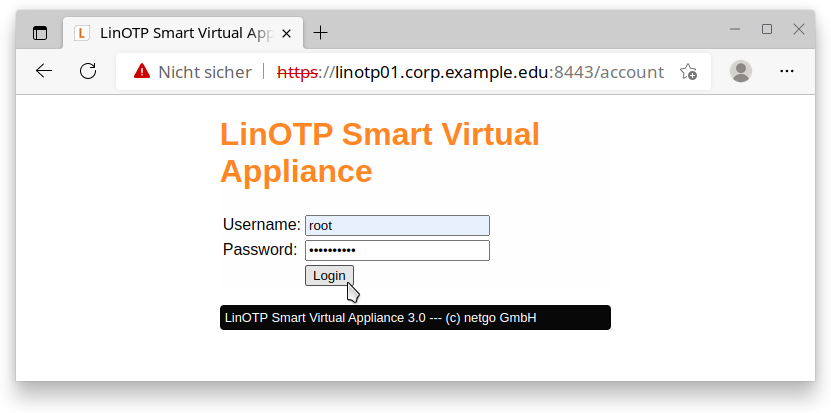
After the successful login you should see the following welcome screen:
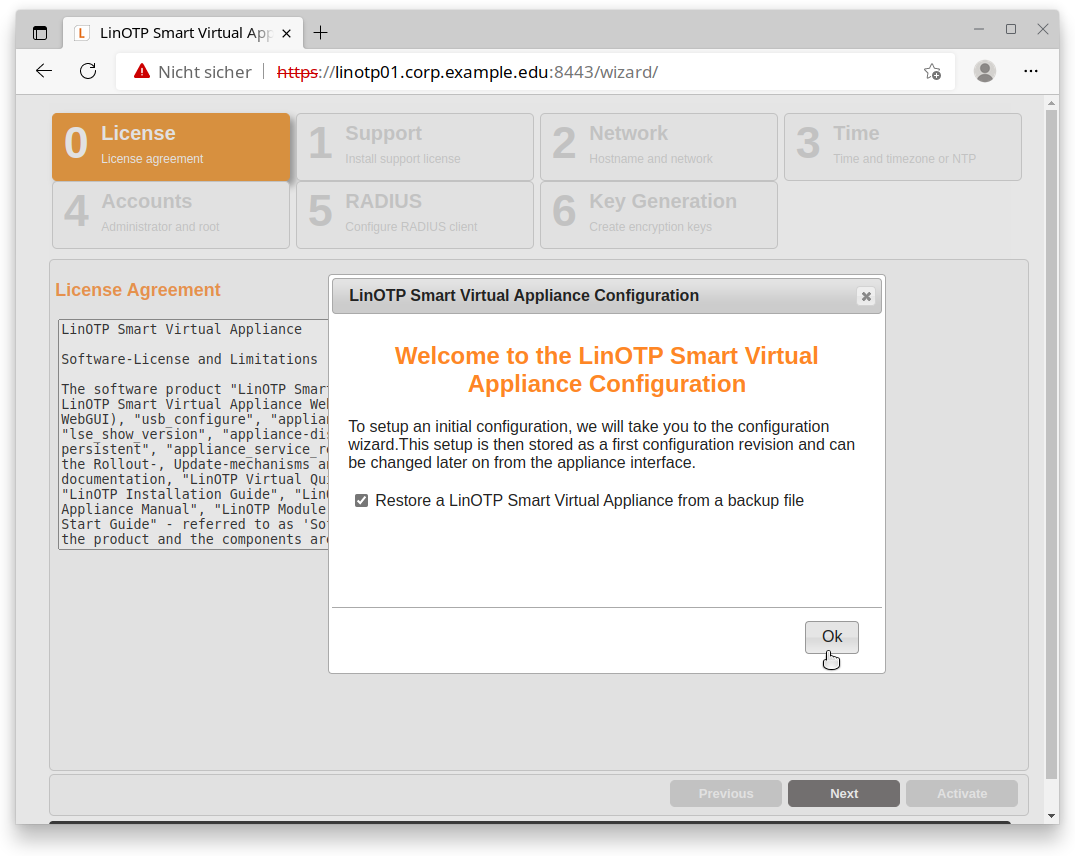
This is the setup wizard. It can be used to configure your new LinOTP Appliance and to restore your backup.
Restore LinOTP Appliance Configuration
Right after the login you will be asked whether you want to restore a backup or to setup the new machine manually. Please check the box “Restore an LinOTP Smart Virtual Appliance from a backup file” and continue. You will see the head of the website changing to contain fewer configuration items.
Warning
The full backup of a SVA version 2.x can only be restored at this point. If you decide to set up the new SVA without restoring the backup in the wizard it will be still possible to import the database and the encryption key via the Appliance dashboard (https://<LINOTP>:8443 –> System –> Restore, see Restore Settings and Data for details). A full restore is not possible anymore and will potentially damage the system.
0. License Agreement
Please read the license agreement carefully. To advance to the next step, check the box following “I accept the license agreement” and click on “Next”. By doing so, you declare your acceptance of the license agreement.

1. Accounts

The LinOTP Appliance generally recognizes three different roles:
LinOTP Administrators – the LinOTP Admins are responsible for token and user management (https://<IP_OF_LINOTP/manage>). They do not have any rights on the level of the Appliance operating system or on the network level - these accounts will be restored from the backup file.
Root Administrator – the Root Admin has the most rights. This role can do everything except manage the LinOTP.
Appliance Administrator – the Appliance Admin may only change the Appliance functions and provide access rights. He may change passwords (including root’s password if he can provide the old root password)
Now provide the passwords for the last two roles. The “Old root password” requested for the Root Admin role is the initial root password “eBai6Lait9”.
Note regarding password complexity
For security reasons, be certain to select sufficiently complex passwords when changing the passwords. Passwords are deemed to be sufficiently complex by today’s standards when they meet the following criteria:
Password length of at least 10 characters
Combination of uppercase and lowercase letters, number and special characters
Once you have entered all of the passwords, go ahead to the next step by clicking the “Next” button. Please note that the input mask depicted can only be exited when all fields have been completed and the newly entered passwords are highlighted in green. Scrolling backwards using the “Previous” button is also not possible until the fields have been fully completed.
2. Network
Here you see the current network configuration of your new Appliance. You have to decide, whether you would like to keep this configuration or to restore the network settings from backup. If you want the latter, please choose “Restore network configuration from backup”.
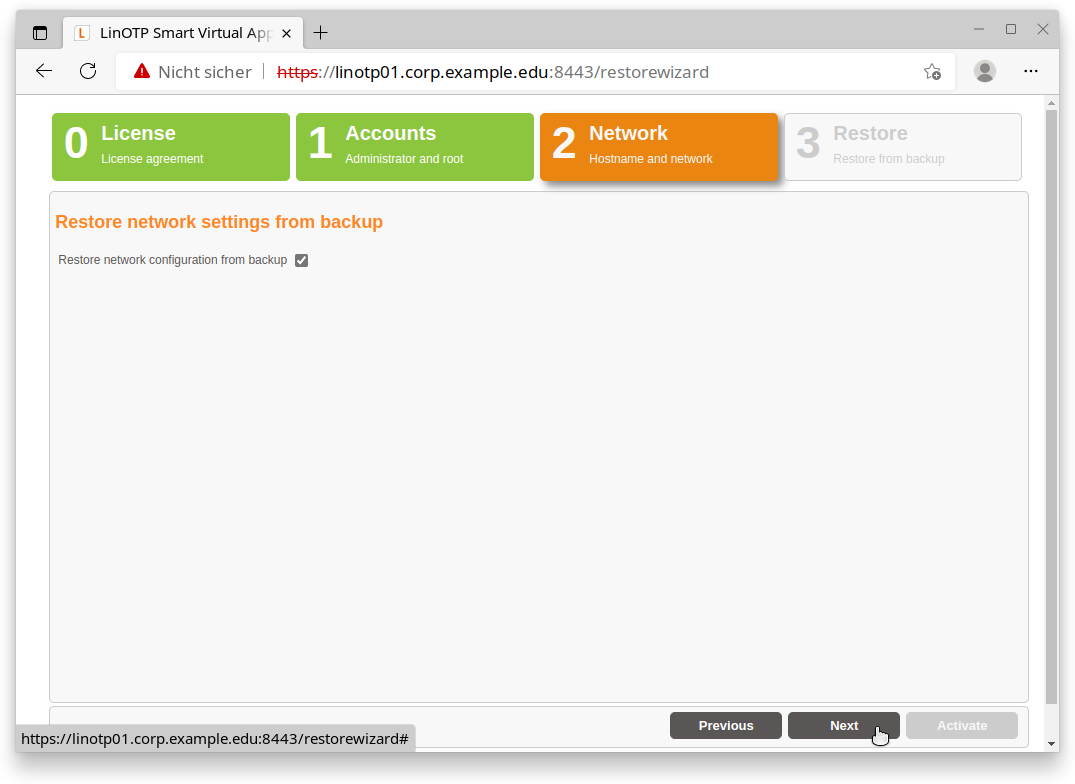
Warning
Please be aware: if your old Appliance is running in the same network environment as the new machine you should not restore the IP from the backup - because both machines would run with the same IP causing problems. So either shutdown the old machine or configure a different network setting for the new one. You can change this configuration at any time later in the management web UI.
If you prefer a manual configuration of the network then fill in the needed information and proceed with the next page:
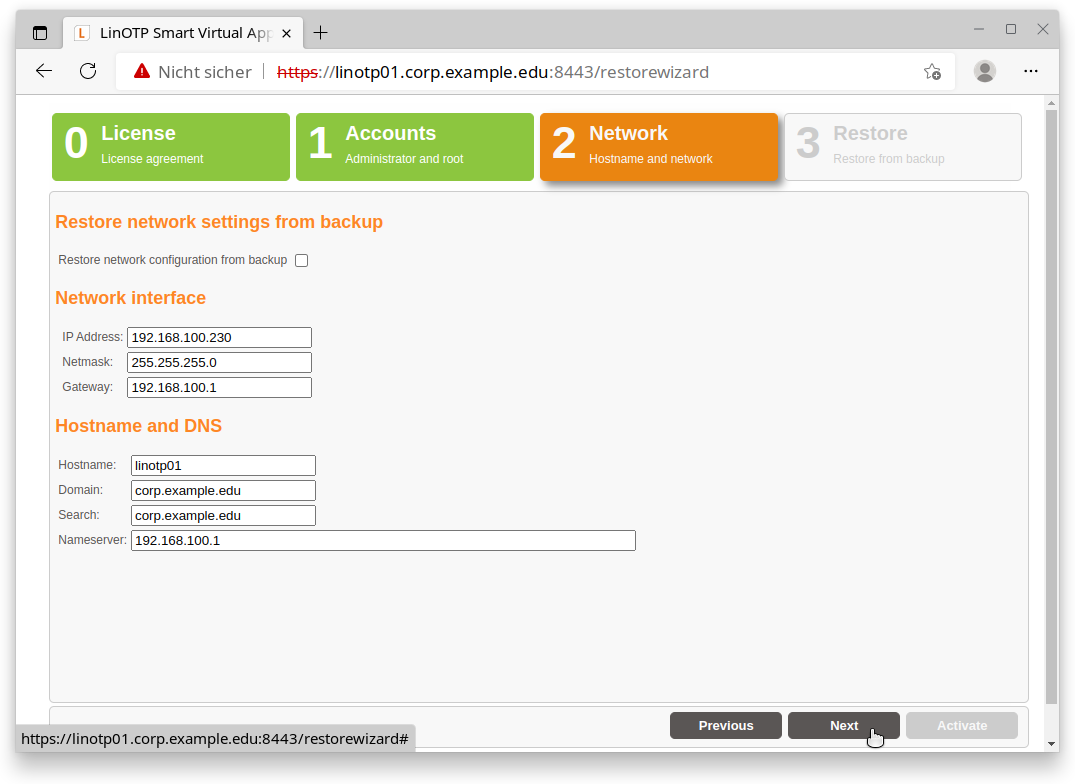
3. Restore
As last step choose the backup file made from the original machine:
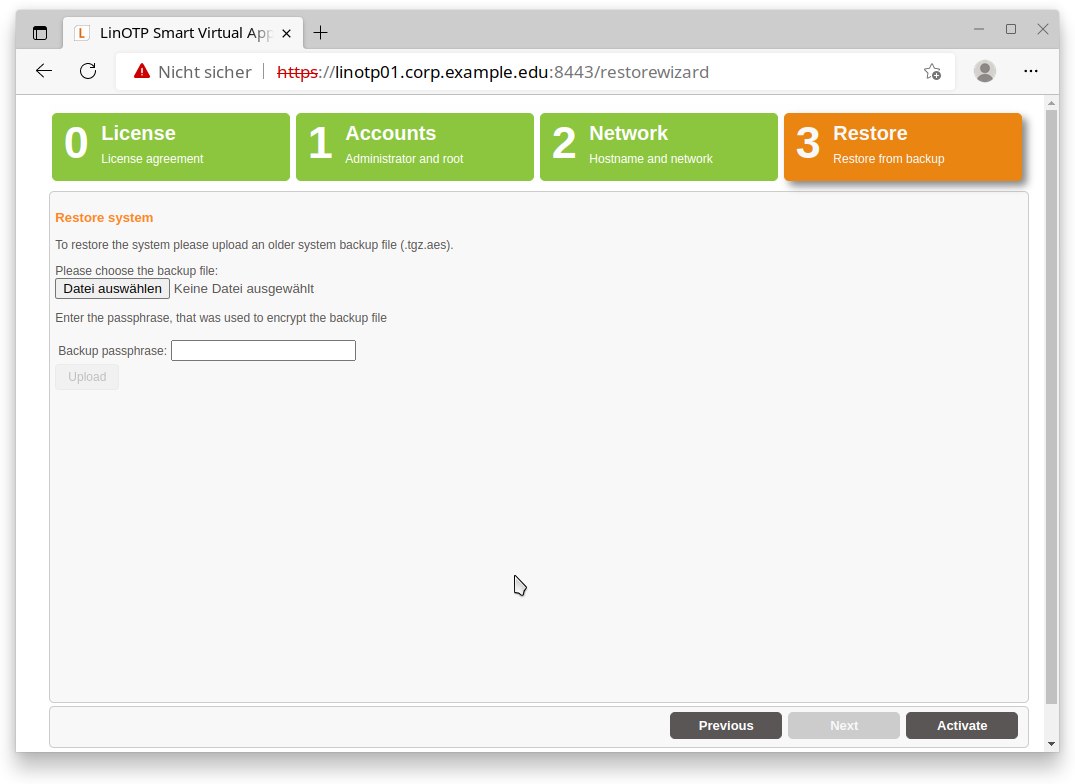
Choose “Select file/Datei auswählen” to select the backup you created earlier.
Enter the passphrase used for encrypting the file:
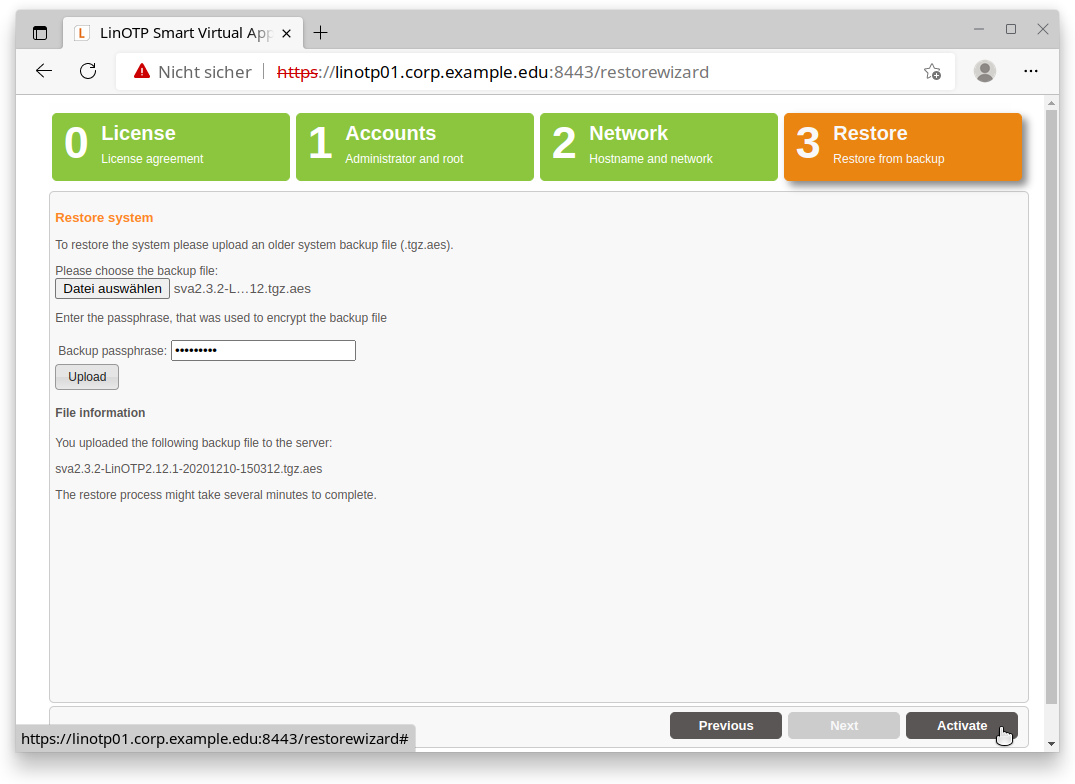
The passphrase decrypts the backup, which may take some time. The process starts with the “Upload” button.
Activate the restore procedure:
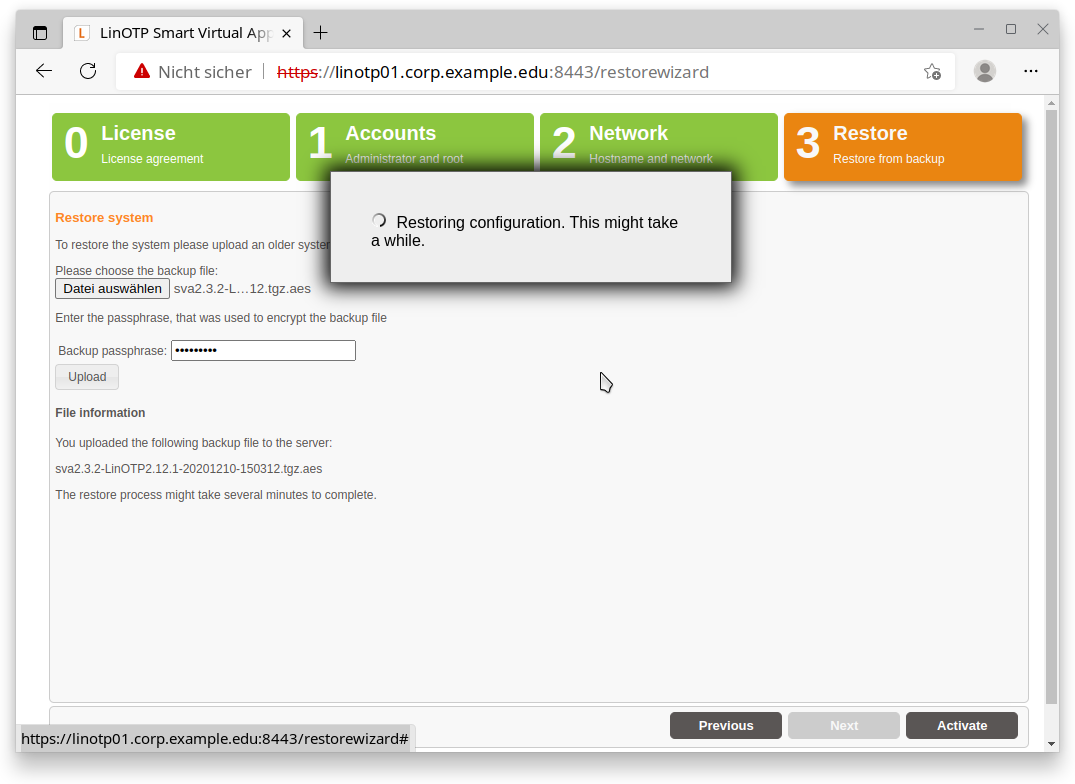
If the file information is displayed, the backup can be activated. The process is time consuming, it is accompanied by a panel with the progress indicator.
And wait until it is finished…
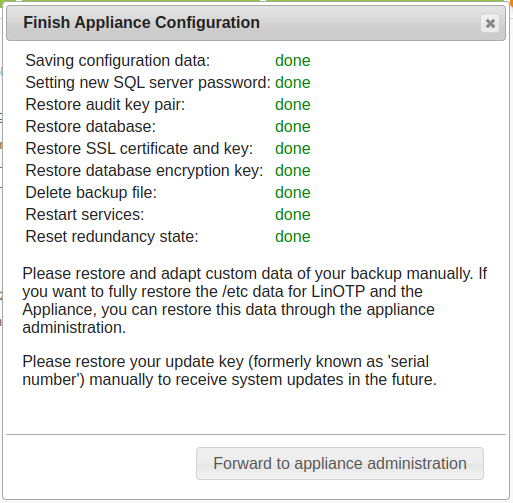
After the procedure is finished, a popup appears. Confirm and you should be forwarded to the management web UI of the new machine. The restore is complete and all configuration settings regarding the Appliance itself and LinOTP (i.e. tokens, UserIdresolver, policies and so on) should be the same as in the original machine.
Note
The old logfiles of Apache are not restored. So if you have any need for them the most convenient way is to perform a backup directly from the original machine.
4.18.4. Troubleshooting for restore#
We have tested the restore process extensively. Problems occur with increasing tendency the older the LinOTP version is.
It is advisable to update the LinOTP to a high available version before the backup. Appropriate versions can be found in our repos of the appliance and LinOTP.
With the change to LinOTP 3 some unused tokens are dropped, the simple pass token is replaced by the password token. In backups containing such dropped tokens they will be missing.
In case of problems, it is useful to trace at which partial step of the restore the process breaks. The SVA writes such information to the log file under /var/log/lseappliance/appliance.log. It may be necessary to repeat the process in debug mode.
For orientation, the following line helps to search:
...lseappliance.lib.system] [appliance_configure] ['sudo', '/usr/bin//appliance_configure.py', '-c', 'restore', '-o', 'list', '-p', '-']
The individual sections then contain lines with remarks about what is being processed:
...[lseappliance.lib.system] [appliance_configure] ['sudo', '/usr/bin//appliance_configure.py', '-c', 'set_mysql_root_password'] ...[lseappliance.lib.system] [appliance_configure] ['sudo', '/usr/bin//appliance_configure.py', '-c', 'restore', '-o', u'do_db']
Here the ‘do_db’ stands for the recovery of the database for LinOTP.
At the beginning it is reported which components were unpacked from the backup. These should be complete as in the following example, otherwise no complete restoration is possible.
/backup.ini /ssl.tgz /mysql.dump /etc.tgz /enckey.tgz
4.18.5. Create administrators after restore#
After the restore is complete, the logins for SVA https://<LinOTP_IPorFQDN>:8443/ and LinOTP Management https://<LinOTP_IPorFQDN>/manage are ready.
The SVA can be logged into by root or appadmin with the newly assigned passwords.
At least one account must be defined there for the admin of LinOTP. The former admins have become useless due to the omission of authentication in Apache.

After login the tab ‘LinOTP’ is selected.
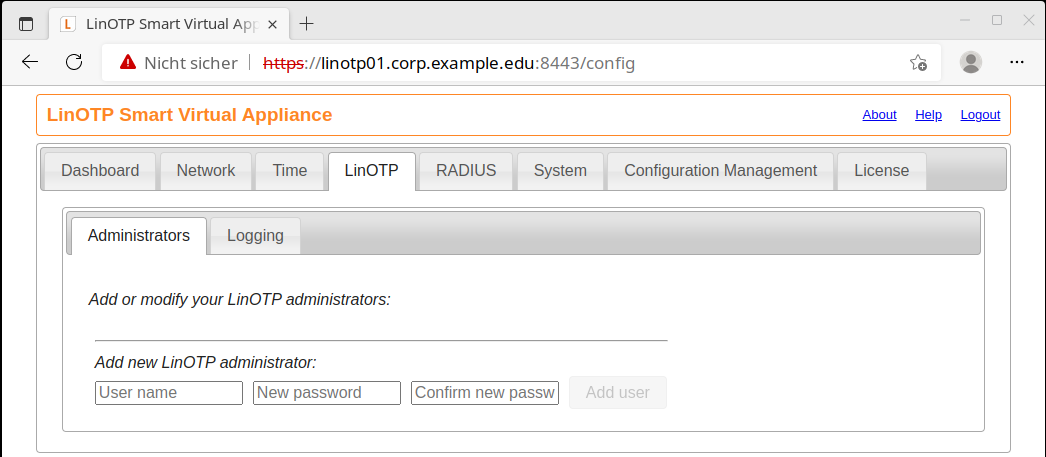
There are no admin users entered under ‘Administrators’. The first administrator is now defined.
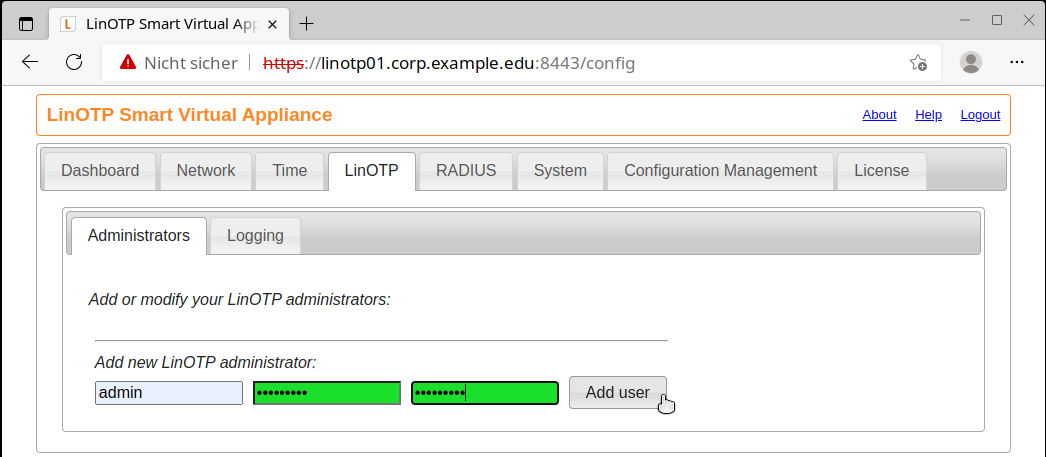
The user e.g. ‘admin’ is stored in the internal UserIdResolver of LinOTP and can log in immediately under /manage.
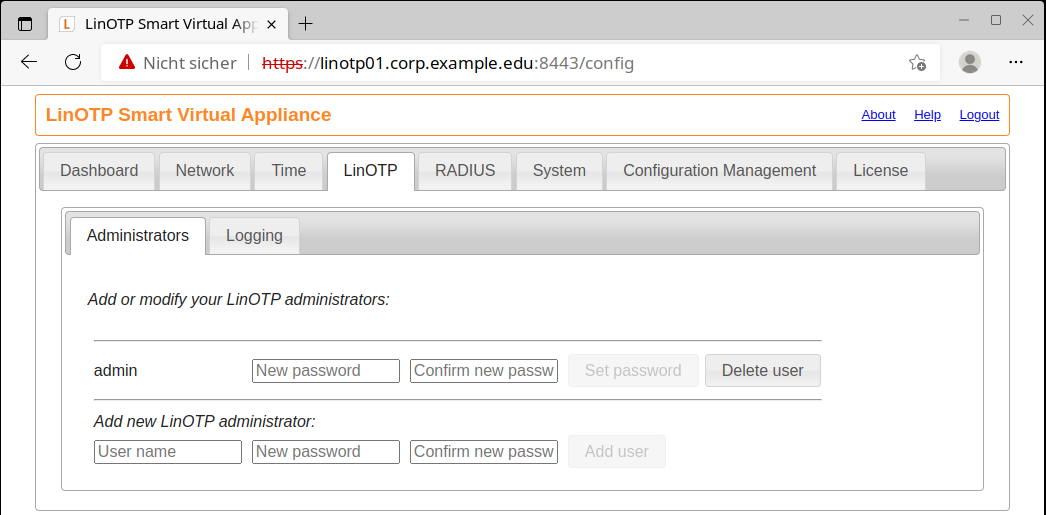
The user e.g. ‘admin’ is stored in the internal UserIdResolver of LinOTP and can log in immediately under /manage.
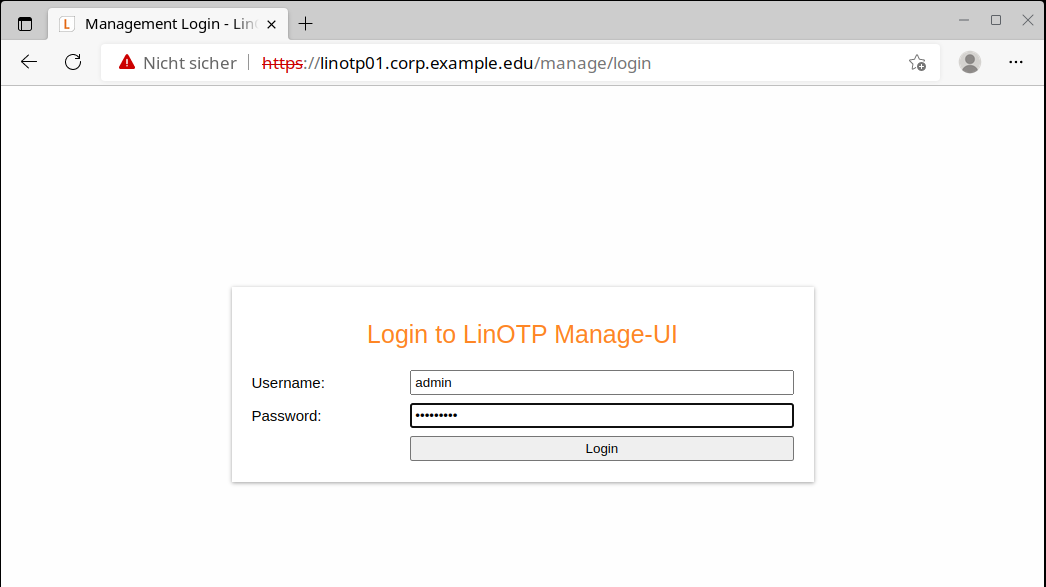
The users created in this way administer LinOTP. They are defined in the resolver ‘LinOTP_local_admins’ within the realm ‘linotp_admins’.
Additional users can be added via the GUI of the SVA. The passwords can also be changed there.
If administrators from a Windows AD group are to be added, a suitable LDAP UserIdResolver must first be defined. Then this can be added to the realm ‘linotp_admins’. LinOTP passes the password check to the AD.
The usernames, UserIdResolver and realms are usable within the policy (also scope admin and system) as before.
Details on this topic are described here: LinOTP Administrators
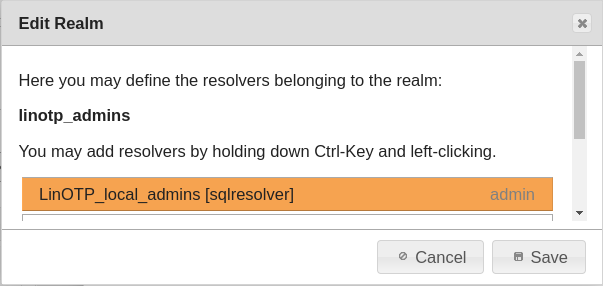
4.18.6. Restoring the redundancy#
Restore both nodes as described above.
Note
It is recommended to deactivate redundancy before performing the backup of the old Appliances. In this case it will be only necessary to reinitialize the replication from the machine with the more recent restored database after the setup of the new Appliances is finished (step 2).
If the redundancy was included in the backup we are going to deactivate the redundancy first and then reinitiate the synchronization from node 1 to node 2.
Log in to the terminals of node 1 and node 2 and execute on both machines (use the root credentials set during the recovery procedure):
appliance_configure.py -c reset_redundancy
Log in to node 1 and execute:
appliance_configure.py -c setup_redundancy -p <IP_OF_NODE_2>
For security reasons you have to make sure to connect to the right machine by comparing the SSH host key displayed during the setup procedure to the one of the second node. You will find the SSH host key in the Appliance management webinterface https://IP_OF_NODE_2:8443 in System -> Advanced -> SSH configuration:
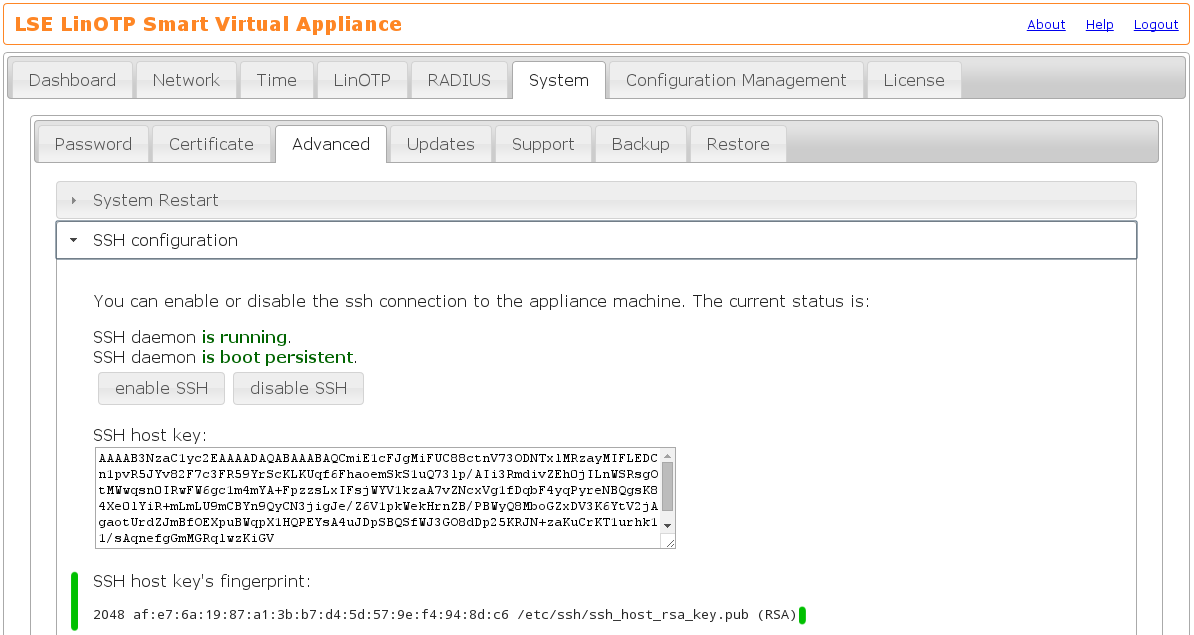
The complete redundancy procedure looks like:
root@linotpappliance:~# appliance_configure.py -c setup_redundancy -p 192.168.122.161
Welcome to the redundancy wizard.
Please make sure that timer_entropyd is running.
Do you want to setup IPSec-based encryption between the machines? [y/n] "y"
You will have to verify the partner hostkey fingerprint and give the partner's
root password in order to start the setup process.
Since the SSH command only waits for input for a certain time, please make
sure that:
* the partner hostkey fingerprint
* the partner root password
are close at hand.
You can find the partner hostkey fingerprint at https://192.168.122.161:8443/
at System-Advanced-Redundancy.
Please hit RETURN to continue:
The authenticity of host '192.168.122.161 (192.168.122.161)' can't be
established.
RSA key fingerprint is af:e7:6a:19:87:a1:3b:b7:d4:5d:57:9e:f4:94:8d:c6.
Are you sure you want to continue connecting (yes/no)? "yes"
root@192.168.122.161's password:
bind: Cannot assign requested address #not an error
Success!
Terminating the SSH tunnel ... (this is expected!)
Now both nodes should now work in sync - please proceed with the test procedures described below.
Note
If you had any special configuration settings in the old Appliance you have to apply them carefully by hand - please be aware of changes between Debian Squeeze and Debian Jessie (e.g. you have to consider the new configuration syntax of Apache 2.4).
4.18.7. Transferring customizations#
With the transition from LinOTP 2 to LinOTP 3 some things change in the substructure of LinOTP, this results in special features for the customizations on the LinOTP server, they cannot be transferred, they have to be implemented new instead.
Particularly to consider:
Administrators of LinOTP (/manage) The login is no longer performed by the Apache server. LinOTP now handles this function itself and requires configuration for this.
Details under: Managing LinOTP token administrators
Certificates can now be managed via the certificate store of the operating system.
Adaptations of the GUI in /manage or the self-service must be discarded and completely rebuilt.
Adaptations to RADIUS are particularly difficult In addition to the transfer, a transition from freeradius v2 to freeradius v3 may also have to be made.
Transferring modified database connections.
Transferring additionally installed software for monitoring, etc.
4.18.8. Check the new LinOTP Appliance#
Note
If you have not yet entered an update key under license, do so first.
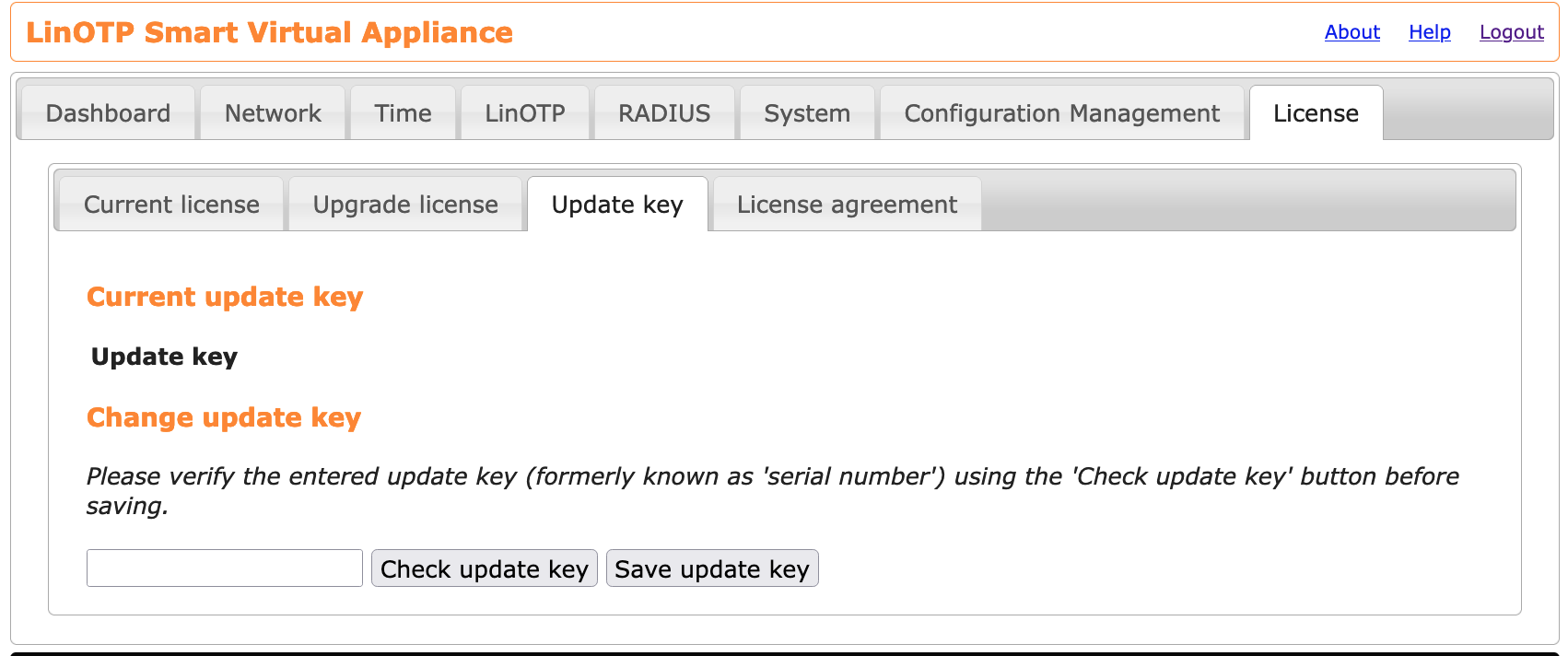
Review the success of the restore procedure. Log in to the Smart Virtual Appliance management webinterface (consider that the IP might have been changed due to the recovery):
https://IP_OF_YOUR_LINOTP:8443
Note
In case you can not connect to the webinterface: If something went wrong and you are unable to reach the Appliance e.g. because of a wrong IP you can log into the console of your virtual system using username “root” and the appropriate password as it was set in the backup. Enter the command unsupported. Now you have full administrational access and you can fix the wrong IP with ifconfig eth0 IP_YOU_WANT. Now you should be able to connect to the webinterface to check and fix configuration there.
Check configuration:
Have a look at least at:
network/routing/hostname/DNS settings
correct time configuration
If used: the RADIUS setup - are all client configurations correctly restored?
Be aware:
Not all configuration details are backuped and restored by LinOTP Appliance. So if applicable please review after the recovery procedure special settings you remember like:
deactivated/activated services, e.g. haveged or sshd
SSH server- and clientkeys & SSH server configuration itself
Finally connect to the token- and user management webinterface:
https://IP_OF_YOUR_LINOTP/manage
Are the UserIdResolver working correctly and are the users displayed in User View sorted by their realms?
Do you see tokens in Token View and are they assigned to users?
Are the policies restored?
Note
Node recovery:
Rollout an example token on one of the nodes and assign it to a test user. Switch to the other machine and check if you can see the token and the assignment there as well.
Test if Appliance is working properly:
If you possess a test account, please try to authenticate by accessing
@https://<IP_OF_YOUR_LINOTP>/validate?user=TESTUSER&pass=PINOTP
Where the possible parameters are:
- user
the name of the user that should be authenticated
- pass
in most cases a combination of the PIN and the OTP of the user
- realm (optional)
the realm of the user; must be specified, if the user is not member of the default realm
In case of success you should see something like this:

If RADIUS is used you should additionally check whether a user can authenticate via this infrastructure as well.
Note
If your original Appliance was used during the migration procedure, the data of the new machine might be a bit older (they originate from a backup some time ago). This may imply that e.g. the HMAC counter of the tokens might be out of sync with the data of the restored database. So you probably have to ask your users to go to the Selfservice Portal and resynchronize their tokens. You can provide the necessary ability for your users by configuring the selfservice policy resync as described in http://www.linotp.org/doc/latest/part-management/policy/selfservice.html.
